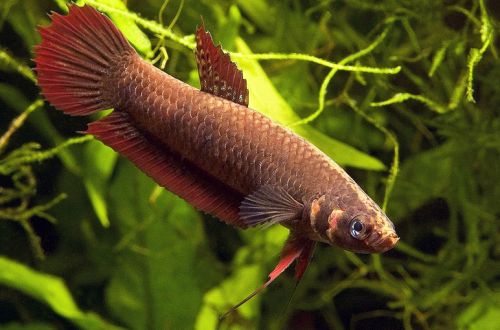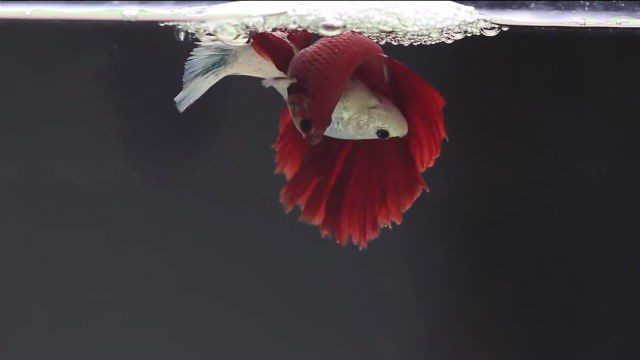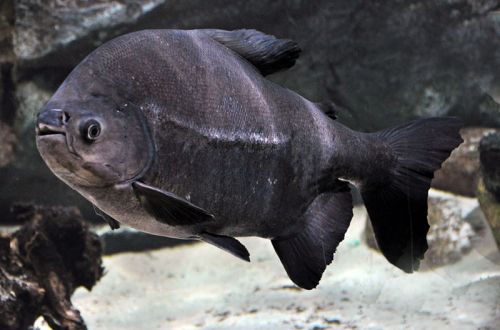
cockerel wine
The wine cockerel, scientific name Betta coccina, belongs to the Osphronemidae family. Beautiful fighting fish of rich crimson color. The content is quite simple, subject to the necessary conditions, and can be recommended to beginner aquarists.
Groups / classification of fighting fish (Petushkov)

Contents
Habitat
It comes from the island of Sumatra in Southeast Asia. It lives in peat bogs and associated streams under the canopy of dense tropical forest. The crowns of trees are so dense that direct rays of light practically do not reach the surface. The water has a rich brown color due to the abundance of organic matter (fallen leaves, branches, fruits of trees), so the pH values in natural reservoirs are 3.0 or 4.0, i.e. very acidic. The water level is not stable and can drop significantly, turning the swamps into puddles, however, the fish are able to survive in such conditions for several weeks in anticipation of the rainy season.
Brief information:
- The volume of the aquarium – from 40 liters.
- Temperature – 22-30°C
- Value pH — 4.0–6.0
- Water hardness – soft (1-8 dGH)
- Substrate type – any
- Lighting – subdued
- Brackish water – no
- Water movement – little or no
- The size of the fish is up to 6 cm.
- Meals – any
- Temperament – conditionally peaceful, timid
- Keeping alone or in pairs male / female
Description
Adults reach a length of about 6 cm. The color is a rich crimson hue or wine color, which is why the fish got its name. Sexual dimorphism is insignificant, males, unlike females, have more elongated and extended fins.
How to determine the age of Cockerels (Betta Fighting Fish)
Food
In the wild, they feed on small insects and their larvae. In an aquarium, they are able to accept high-quality dry food in combination with live products (brine shrimp, daphnia, bloodworms). An alternative is special food for fighting fish, which includes the Wine Cockerel, which contains all the necessary vitamins and minerals for growth and maintaining the brightness of the color. When choosing, give preference to feed from well-known manufacturers.
Maintenance and care, arrangement of the aquarium
The tank from 40 liters is suitable for one or two fish. Large driftwood and other objects are used in the decoration, for example, decorative castles, sunken ships or ceramic pots turned over on their side. The substrate is sandy, usually covered with fallen leaves. You can use oak leaves that are pre-dried and then soaked in a container to begin to sink, otherwise they will simply float to the surface. Shade-loving plants, including floating ones, are everywhere.
The Wine Cockerel has been successfully bred in commercial aquariums for a long time and is not caught for sale from the wild, so the above arrangement is desirable but not required. The fish will also feel great in an almost empty tank if the following requirements are met: subdued lighting, no internal flow and appropriate water parameters.
Water conditions, in turn, have acidic pH values with low carbonate hardness (dGH). It is advisable to use a filter with a peat-based filter material that can acidify water during its operation. The leaves used in the decoration also contribute to the creation of conditions characteristic of the natural habitat, namely, in the process of decomposition, they color the water in a light brown color and saturate it with tannins.
Provide the aquarium with a lid, under which a moist, warm air layer forms near the surface, which is important for the respiration of labyrinth fish.
Maintenance comes down to weekly replacement of part of the water (10–15% of the volume) with fresh, regular cleaning of the soil from organic waste (excrement, uneaten food residues), periodic replacement of leaves, if they are used.
Behavior and Compatibility
Fighting fish are distinguished by a warlike disposition among males entering into fierce fights for territory and females, so only one male should be in the aquarium. The company may be made up of females and/or other peaceful species of similar size and temperament.
Despite its reputation, the Wine Cockerel is quite timid (unless it’s a competitor) and can be easily intimidated by larger and overly active neighbors.
Breeding / breeding
As the mating season begins, males build a bubble nest under broad leaves, under dense floating vegetation, or in a cave-like shelter on the bottom used in decoration. During the construction process, the male is very harsh towards the female and does not let her near the nest until it is ready.
Shortly before spawning, the color of the female will fade, and dark horizontal stripes will appear on the sides. Spawning itself is accompanied by a kind of “embrace”, when the fish, the word, wrap around each other. At the point of climax, milt and a few eggs are released and then placed in the nest. This is repeated several times until all the eggs are released. In total, about 60 eggs will be laid. The female then swims away, leaving the male to protect and care for future offspring.
The fry appear in 24–48 hours and remain in the nest for another 3–4 days, all this time the male carefully picks up those who accidentally fell out / swam out of it. After the fry begin to swim freely, the male will lose interest in them. Adult fish do not suffer from cannibalism and usually do not eat their offspring. However, this does not apply to other aquarium neighbors and it is advisable to transfer the juveniles to a separate tank with identical water conditions. Feed with specialized food for aquarium fish fry.

Fish diseases
The main cause of most diseases is unsuitable living conditions and poor-quality food. If the first symptoms are detected, you should check the water parameters and the presence of high concentrations of hazardous substances (ammonia, nitrites, nitrates, etc.), if necessary, bring the indicators back to normal and only then proceed with treatment. Read more about symptoms and treatments in the Aquarium Fish Diseases section.
Common diseases of fighting fish (Petushkov)





